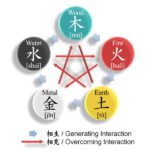Introduction
The Korean Peninsula, situated at the northeastern edge of the Asian continent, has historically occupied a pivotal geographic position in East Asia. Bordered by China to the northwest and Japan to the east, Korea has long been a crossroads of cultural and political exchanges. This unique location has contributed to the complex interplay of influences it has experienced from both neighboring powers, particularly China and Japan. Understanding this historical context is essential for comprehending Korea’s modern trajectory.
Throughout various periods, both China and Japan have exerted significant influence over the Korean Peninsula. China, with its ancient civilization, has historically been a primary cultural and political force in Korea. The tributary system, where Korea acknowledged China’s supremacy while enjoying a degree of autonomy, exemplified this intricate relationship. Chinese ideologies, Confucian values, and technological advancements permeated Korean society, shaping its political institutions, educational practices, and social norms.
In contrast, Japan’s influence intensified during the late 19th and early 20th centuries, particularly with the rise of Japanese imperialism. The annexation of Korea by Japan in 1910 marked a profound transformation in Korean society, as colonial rule led to widespread changes in governance, economy, and culture. The imposition of Japanese language and education sought to assimilate Koreans, resulting in significant resistance and a national identity crisis among the population.
Given the geopolitical sensitivities in East Asia today, understanding the historical influences of China and Japan on Korea is not merely academic; it is a critical lens through which we can analyze modern tensions and collaborations in the region. The legacy of these influences continues to shape contemporary Korea’s diplomatic relations, cultural exchanges, and national identity. Thus, a comprehensive analysis of the impacts of both China and Japan provides valuable insights into the complexities of modern Korean history.
The Legacy of Chinese Influence
The historical ties between Korea and China have profoundly shaped the development of Korean society, culture, and politics. One of the most significant contributions from China is the introduction of Confucianism, which became a guiding philosophy during the Goryeo and Joseon dynasties. Confucian ideals emphasized social harmony, respect for hierarchy, and filial piety, ultimately influencing Korean governance and societal structures. This philosophical framework was instrumental in the formation of a centralized state, which prioritized moral governance and education.
In addition to Confucianism, Buddhism, which also originated in India, was transmitted to Korea via China and played a vital role in shaping Korean spirituality and art. The establishment of Buddhist temples and the commissioning of ornate statues and paintings during the Goryeo period demonstrated the cultural synthesis resulting from this influence. Moreover, the spread of Buddhist teachings cultivated a distinct Korean identity that blended indigenous beliefs with foreign elements.
The adoption of the Chinese writing system and later the development of the Korean script, Hangul, are further testaments to the enduring impact of Chinese culture. Initially, Koreans relied on Classical Chinese for official documents and literature, which established a linguistic connection with the broader East Asian region. This engagement with the Chinese script represented not only a means of communication but also an avenue for intellectual exchange, allowing Korean scholars to participate in the greater discourse of Confucian and Buddhist thought.
Throughout these historical periods, Korea’s relationship with China oscillated between vassalage and independence, revealing a complex interplay of power dynamics. Sinocentrism, the belief that China was the cultural center of the world, positioned Korea within a tributary system, and this perception evolved significantly into the modern era. As Korea navigated its identity amidst external influences, the legacy of Chinese thought and culture remained instrumental in shaping its national consciousness.
Japanese Colonial Rule (1910-1945)
The period of Japanese colonial rule over Korea, spanning from 1910 to 1945, marked a significant turning point in the nation’s history. Under Japanese imperialism, Korea experienced profound changes that aimed at assimilation and cultural erasure. This era saw the Japanese government implement policies designed to suppress Korean culture, language, and national identity. Educational systems were altered to prioritize the Japanese language and history, while traditional Korean customs and practices were systematically undermined. This led to a widespread loss of cultural heritage, igniting a sense of dislocation and grief among the Korean populace.
Economically, Japanese rule brought about significant changes as well, primarily focusing on the extraction of resources to benefit Japan’s own industrial needs. Korea’s agricultural sector was transformed to serve Japanese interests, resulting in land dispossession and increased poverty among Korean farmers. The introduction of heavy taxation and exploitative labor practices further exacerbated social inequalities. Such economic transformations were not merely a side effect of colonial rule, but rather a central strategy of domination that sought to integrate Korea into the Japanese imperial economy.
The harsh realities of colonial rule sowed the seeds for resistance movements, leading to a burgeoning sense of Korean nationalism. Various forms of resistance emerged, from armed uprisings to cultural preservation efforts, as Koreans sought to reclaim their identity. These acts of defiance, such as the March 1st Movement in 1919, highlighted the indomitable spirit of the Korean people and their struggle for independence. The legacy of Japanese colonial rule continues to influence contemporary Korean society, shaping its historical memory and contributing to ongoing discussions about national identity and reconciliation with the past.
Post-World War II: The Division of Korea
In the aftermath of World War II, the peninsula of Korea experienced a significant transformation, leading to its division into two distinct entities: North Korea and South Korea. This partition was largely influenced by foreign powers, notably the United States and the Soviet Union, who occupied the southern and northern regions, respectively. This geopolitical divide not only emerged from the immediate post-war landscape but was also shaped by decades of historical relations with neighboring nations, particularly China and Japan.
The legacy of Japanese colonial rule from 1910 to 1945 had a profound impact on Korea’s socio-political evolution. As Japan expanded its empire, it implemented structures and ideologies that still echoed in both Koreas following the end of Japanese occupation. For North Korea, the harsh experiences of colonialism fostered a strong sense of nationalism and distrust toward external influences, which aligned with the rise of communism, particularly Chinese communism. The Soviet Union’s support for North Korea under Kim Il-sung further bolstered the establishment of a communist state that echoed the principles of its Chinese ally.
Conversely, South Korea reflected a markedly different ideology, influenced significantly by the United States and its democratic values. Japan’s post-war reconstruction efforts, supported by American economic aid, created a favorable environment for the emergence of a capitalist economy in South Korea. This strong economic foundation, alongside Japan’s vested interest in cultivating a friendly relationship with South Korea, positioned the latter to flourish as a key player in the global market.
Throughout the Cold War, the ideological chasm between the two Koreas deepened, often reflecting the larger geopolitical struggle between communism and capitalism, profoundly shaped by the historical experiences with China and Japan. Understanding these dynamics is essential in recognizing how historical dependencies and relationships continue to influence both nations today.
Modern Sino-Korean Relations
In recent years, the relationship between China and South Korea has evolved significantly, reflecting a complex interplay of economic, cultural, and political dimensions. Economically, the partnership has strengthened, as South Korea has positioned itself as a key player in China’s Belt and Road Initiative. Bilateral trade has expanded, with China becoming South Korea’s largest trading partner, while South Korean companies have significantly invested in various sectors in China, such as technology and manufacturing. This economic cooperation is pivotal, as it facilitates growth and provides mutual benefits to both countries.
Culturally, exchanges between China and South Korea have flourished, with increased tourism, joint ventures in the entertainment industry, and academic collaborations. Initiatives like the Korea-China Cultural Exchange Year have sought to enhance mutual understanding and appreciation. However, cultural diplomacy also faces challenges, chiefly due to historical grievances stemming from Japan’s colonial rule and the comfort women issue, which continue to cast a shadow over Sino-Korean relations. These issues not only affect public sentiment but also influence governmental policies, making reconciliatory efforts essential for a sustainable partnership.
Politically, Sino-Korean relations are complicated by North Korea’s unpredictable behavior and its reliance on China for economic support. China’s role as a stabilizing force on the Korean Peninsula is crucial; however, its influence over North Korea often raises security concerns for South Korea and its allies. The complex dynamics of the North Korean nuclear issue further strain the dialogue between China and South Korea, requiring careful navigation of diplomatic relations. On one hand, South Korea seeks greater security through alliances with the United States; on the other hand, it is aware of the necessity to address the economic and political ramifications of its relationship with China. Understanding these multifaceted interactions is essential for grasping the current state of modern Sino-Korean relations.
Japan-Korea Relations Today
The contemporary relationship between Japan and both Koreas is marked by a complex interplay of historical grievances and current geopolitical dynamics. The legacies of Japan’s colonial rule over the Korean Peninsula from 1910 to 1945 continue to reverberate through diplomatic, economic, and cultural interactions today. Among the most contentious issues are the unresolved matters pertaining to forced labor, sexual slavery, and the status of historical documentation. These issues have fostered persistent tensions that often overshadow potential cooperative endeavors.
In the North, diplomatic ties with Japan remain fraught with complications, catalyzed by Pyongyang’s nuclear ambitions and frequent military provocations. The abduction of Japanese citizens by North Korea in the 1970s and 1980s adds another layer of animosity, hindering efforts to establish a constructive dialogue. Consequently, relations between the two nations are largely characterized by mutual distrust, limiting opportunities for diplomatic engagement and collaborative security initiatives in the region.
Conversely, South Korea’s relationship with Japan is similarly strained due to historical issues; however, it reflects a mix of cooperation and conflict. Economic partnerships exist, exemplified by trade relations that are significant for both nations, yet the shadow of historical grievances often emerges, creating friction, particularly regarding public sentiment. Nationalistic movements in South Korea occasionally lead to calls for boycotting Japanese products, illustrating how historical issues can influence contemporary trade dynamics. Furthermore, despite the shared democratic values and regional security interests that could foster closer ties, public opinion in both countries remains heavily influenced by historical narratives.
In conclusion, Japan-Korea relations today are still heavily affected by historical issues tied to colonialism and wartime atrocities. Diplomatic interactions, trade relations, and cultural exchanges are regularly overshadowed by a complex web of historical grievances and nationalistic sentiments, indicating that resolution of these issues is pivotal for a more stable and cooperative future.
Cultural Exchanges and Influence
The cultural exchanges between Korea, China, and Japan have significantly shaped the historical and modern landscapes of these nations. From ancient times, Korea has been influenced by Chinese philosophy, literature, and governance models, which laid the foundation for various elements of Korean culture. The introduction of Confucianism and Buddhism from China shaped social norms and educational practices in Korea, fostering a shared cultural framework that persists to this day.
Conversely, Korea has also served as a cultural conduit for introducing Chinese innovations to Japan, particularly during the late Heian period. This interaction led to the adaptation of Chinese writing systems, artistic techniques, and religious practices within Japan. The rapid evolution of the Japanese cultural identity was profoundly impacted by these exchanges, resulting in a unique blend of styles and traditions.
In contemporary times, the Korean Wave, also known as Hallyu, has garnered international acclaim, further intensifying cultural exchanges among the three nations. The global popularity of K-pop, Korean dramas, and film has highlighted the interconnectivity of East Asian pop culture. For instance, many K-pop groups incorporate elements from both Chinese and Japanese music, creating a fusion that attracts diverse audiences, while Chinese and Japanese entertainment industries have likewise adapted aspects of Korean cultural trends to enhance their own offerings.
Cultural diplomacy plays a vital role in fostering understanding and cooperation among Korea, China, and Japan. Through initiatives such as festivals, art exhibits, and joint productions, these countries highlight their shared histories and contemporary cultural narratives. Nonetheless, the historical tensions molded perceptions and contribute to complex interrelations. The evolving nature of cultural influences continues to shape the identities of these nations, making it crucial to comprehend their interconnected histories in a modern context.
Economic Influences and Competitions
The economic interactions between Korea, China, and Japan have significantly shaped modern Korean history, influenced by trade relationships, investment patterns, and competition for technological leadership. Since the late 20th century, South Korea has become an integral player in the regional economic landscape, driven partly by its historical ties to both China and Japan. In particular, the relationship between South Korea and China has boomed in the last two decades, marked by China’s emergence as one of South Korea’s largest trading partners. In 2022, the trade volume between the two nations reached unprecedented levels, illustrating the robust economic ties that have been established.
Conversely, Korea’s economic relationship with Japan has been more complex, characterized by historical grievances but also significant collaboration, particularly in technology and research and development. Japan’s advanced technology sector has often provided a benchmark for South Korea, encouraging competition and innovation. However, tensions arising from historical issues continue to impact trade dynamics, as seen in disputes regarding trade restrictions in recent years. This rivalry has prompted South Korea to seek alternative markets and foster homegrown technologies to reduce dependency on Japanese imports.
The shifting global economic landscape, marked by developments such as the U.S.-China trade conflict, has also prompted realignments in these relationships. The rise of regional trade agreements, particularly the Regional Comprehensive Economic Partnership (RCEP), emphasizes the importance of cooperation within the Asia-Pacific region while still fostering competition among member states. As these nations continue to navigate their economic relationships, the future outlook for collaboration or rivalry remains uncertain. The interplay between economic competition, particularly in technology, and cooperative trade initiatives will be defining factors in the ongoing evolution of Korea’s economic posture within the region.
Conclusion: Looking to the Future
As we reflect on the historical influences of China and Japan on modern Korean history, it is essential to recognize the enduring significance of these relationships. Korea’s past is intricately woven with the legacies of both neighboring countries, from the cultural exchanges and conflicts to the political pressures that have shaped its national identity. The legacies of colonialism and war have not been forgotten, yet they serve as crucial touchpoints for understanding contemporary dynamics among Korea, China, and Japan.
Moving forward, the relationships between these nations are likely to be influenced by a variety of factors, including emerging global trends and shifts in power dynamics. The rise of China as a global superpower and Japan’s reassertion of its regional influence cannot be overlooked. As South Korea navigates its path in the international arena, it must adapt to the changing geopolitical landscape while maintaining its sovereignty and strategic interests.
International organizations are becoming increasingly pivotal in mediating relations among these countries. Dialogues facilitated by institutions such as the Association of Southeast Asian Nations (ASEAN) and the United Nations can create platforms for addressing historical grievances and promoting cooperation. As economic interdependence deepens within the region, collaboration on shared challenges, including trade, environmental issues, and security, becomes ever more vital.
Ultimately, the future of Korea’s relations with China and Japan will depend significantly on resilience, reconciliation, and cooperation. By acknowledging historical injustices and striving towards mutual respect and understanding, there is potential for a harmonious future. The commitment to collaboration will not only benefit Korea, China, and Japan but will also contribute positively to regional stability in Northeast Asia.















